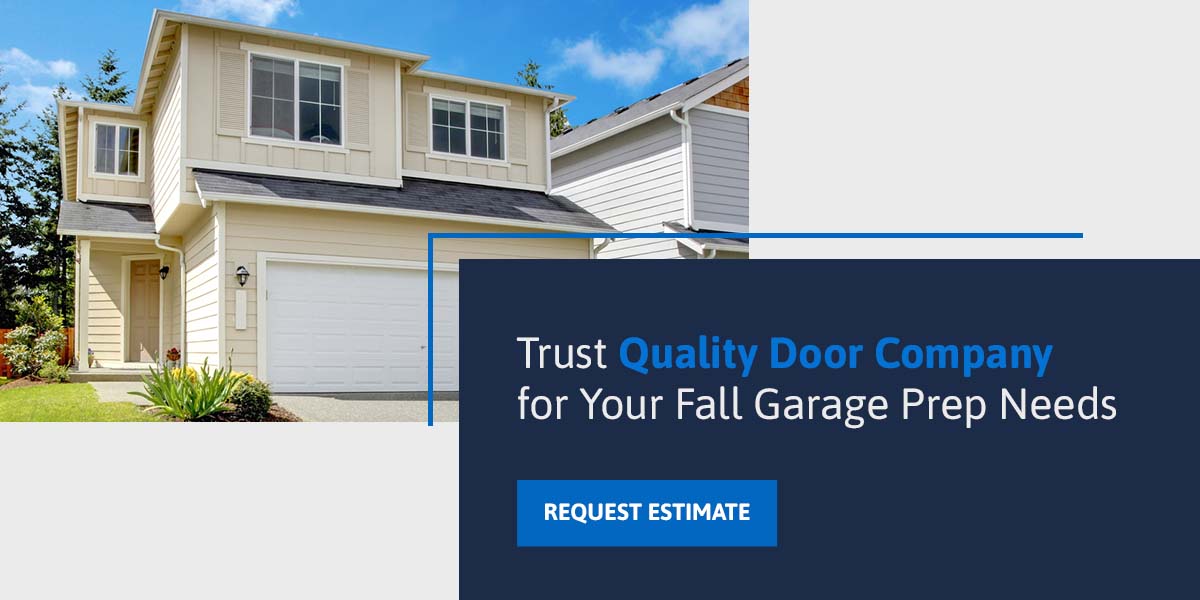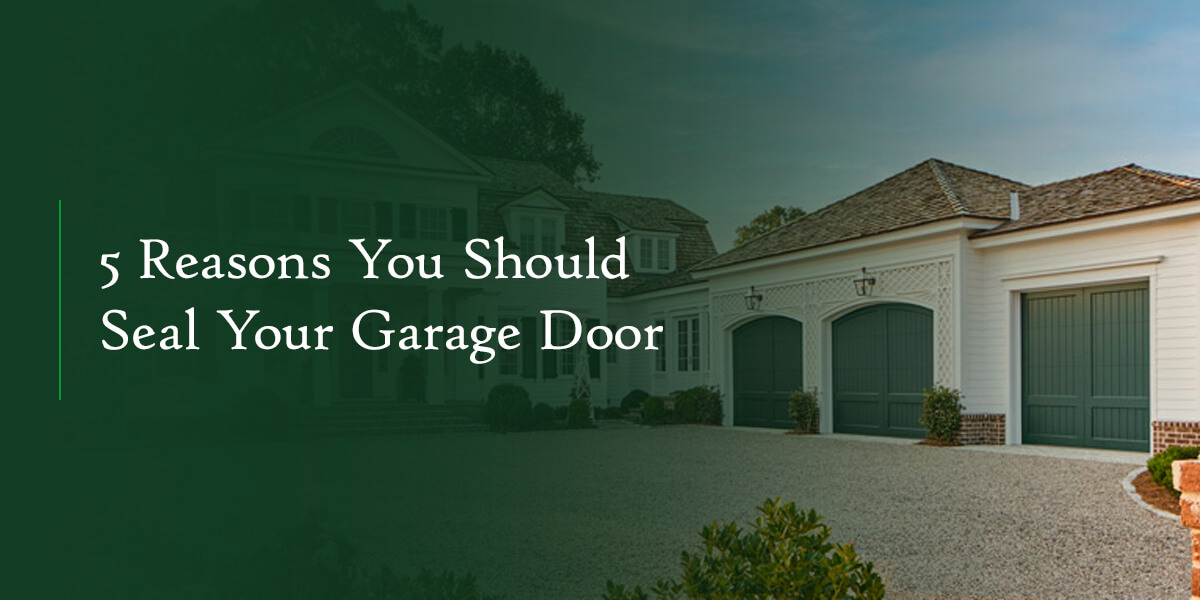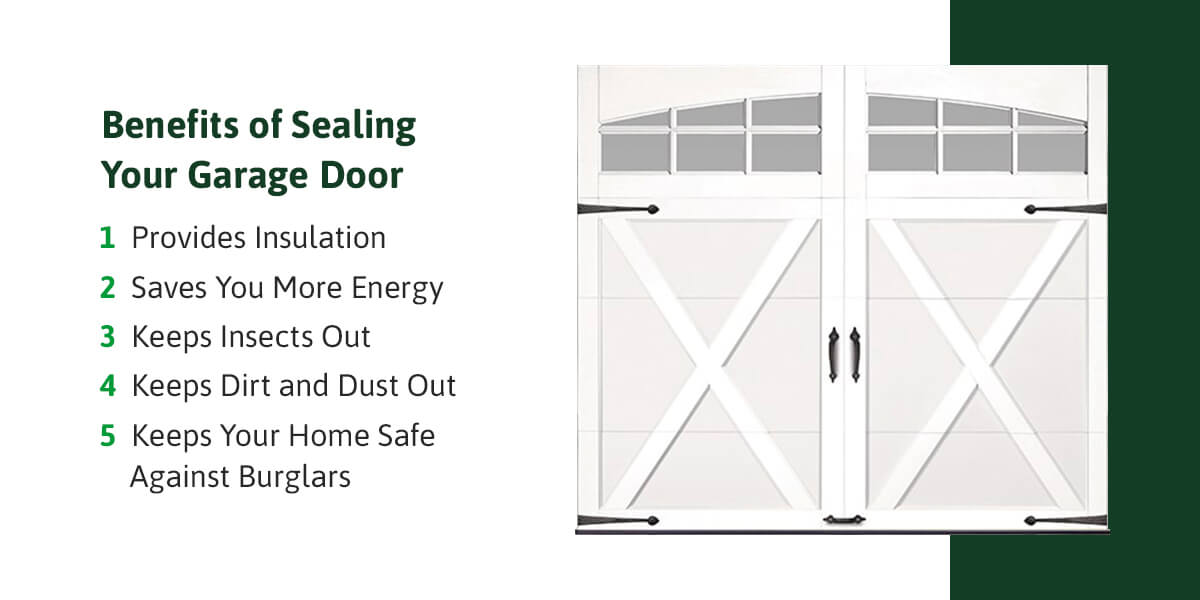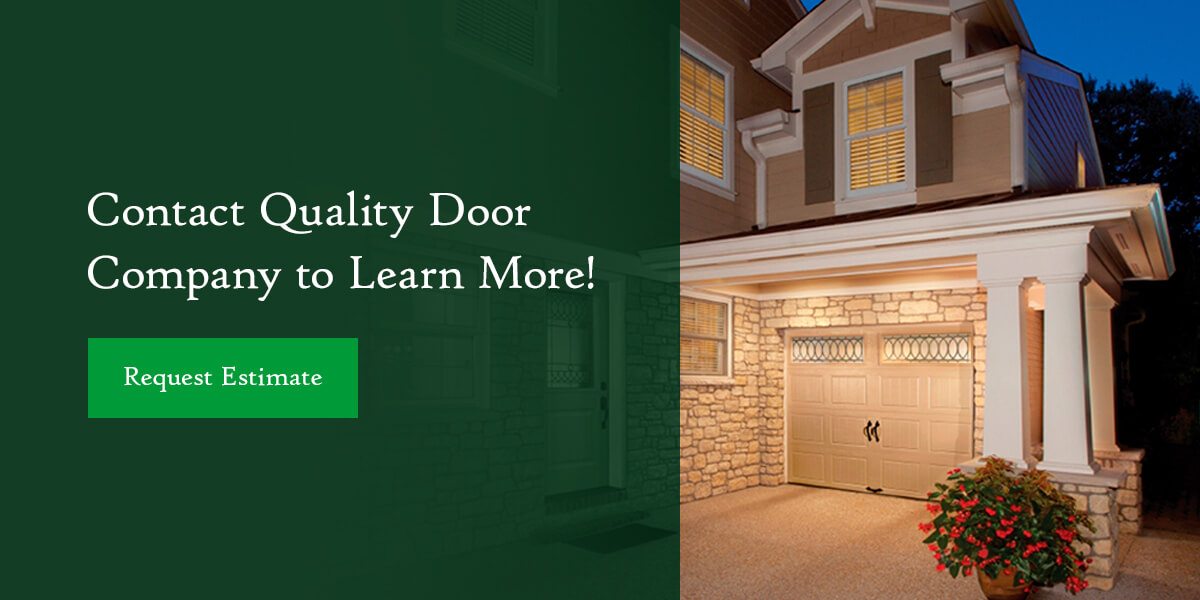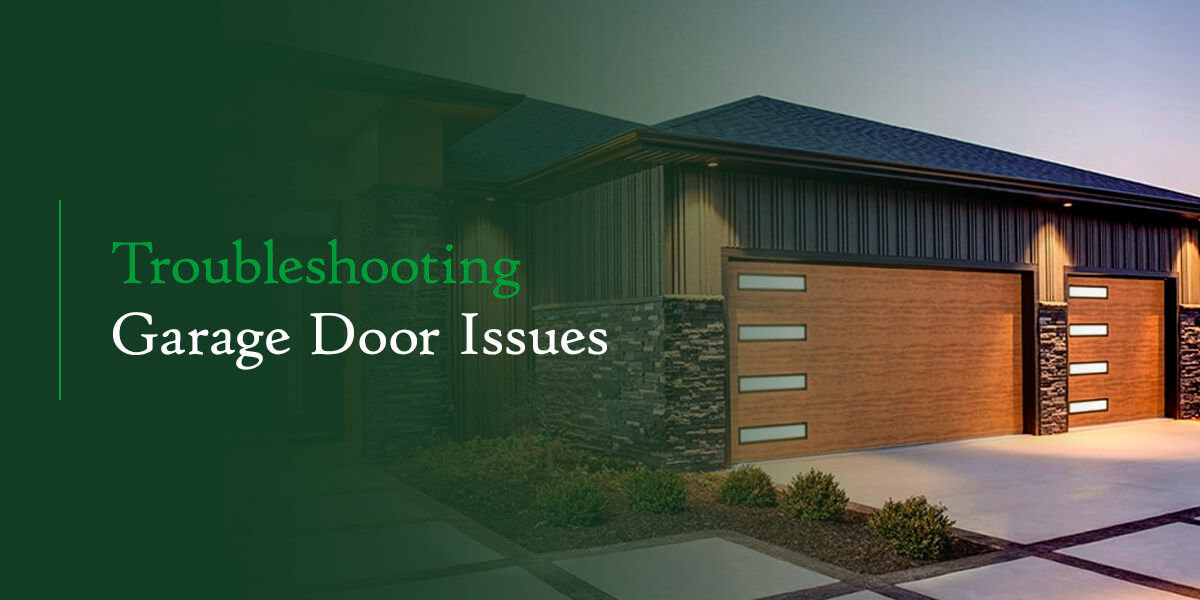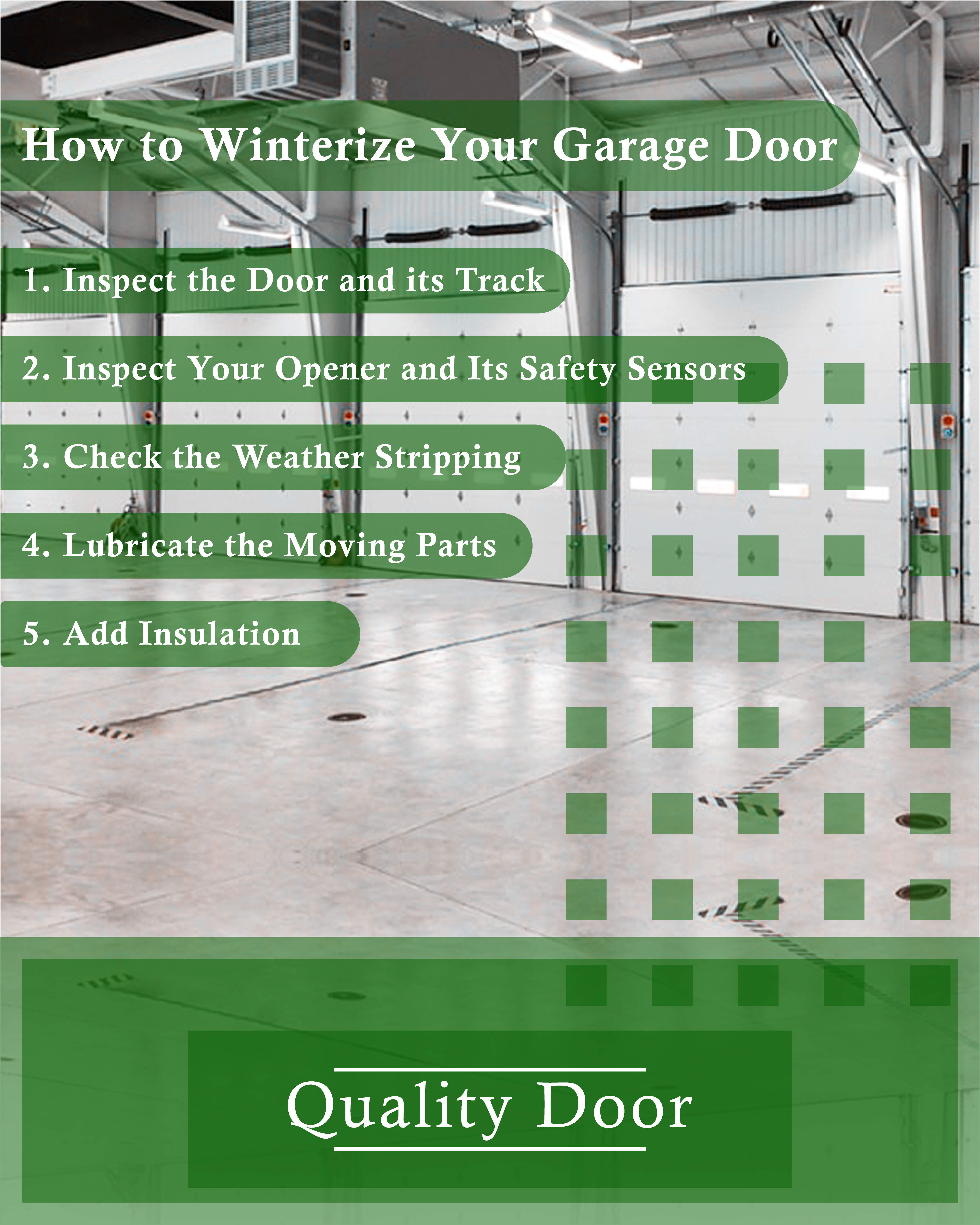Getting Your Garage Door Ready for Fall
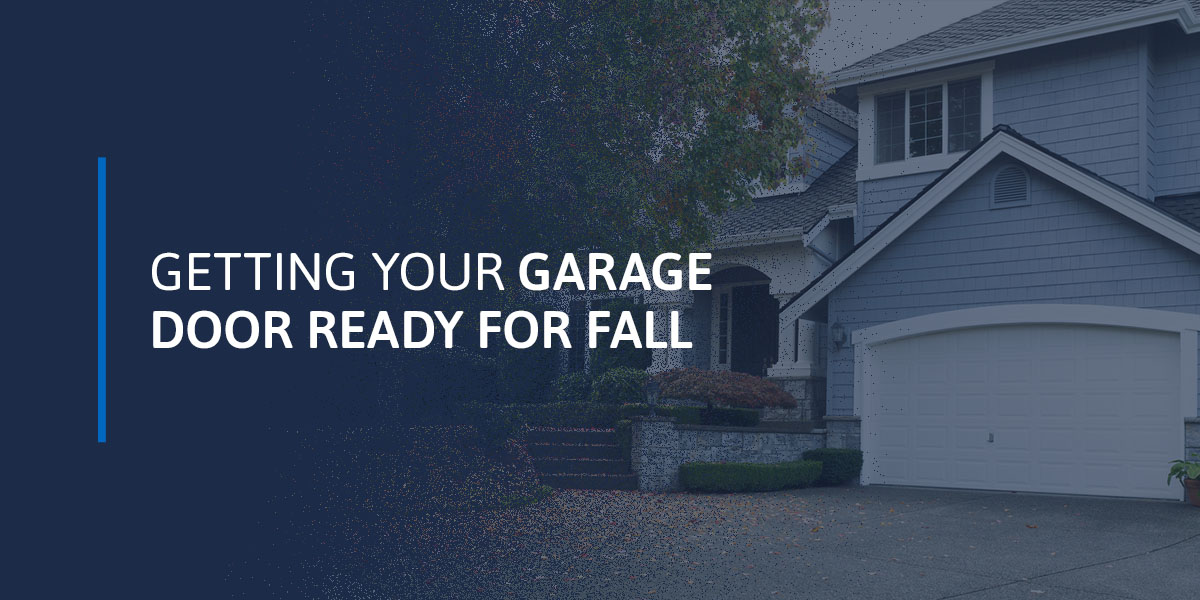
As the crisp autumn air settles across the Midwest, it’s time to turn your attention to an often overlooked but crucial part of your home — the garage. Fluctuating temperatures and eventual frost can lead to issues like contracting metal components, cracking seals and malfunctioning openers. Proper preparation ensures energy efficiency and a prolonged life span of garage components, potentially saving you money on heating bills and costly repairs come winter. This comprehensive guide will walk you through how to prepare your garage for fall to safeguard your home against the harsh Midwest winter ahead.
Essential Fall Garage Prep Steps
Fall garage maintenance creates a safe, efficient and comfortable space that can withstand the winter. It includes several crucial steps:
External Inspection
Examine the garage door for signs of damage, such as peeling paint, cracks or dents, and fix these issues. The cold fall winds and brutal winter air can exacerbate these signs, leading to costly repairs in spring or summer.
Also, examine the springs, cables and rollers for wear. Look for frayed cables, rusted springs or worn rollers. These components ensure your garage door safely operates and should be repaired or replaced at the first sign of wear.
Operational Inspection
Test the door’s operation by opening and closing it several times. Listen for unusual noises that might indicate worn or damaged components. Pay attention to how smoothly the door moves. If it hitches or has jerky motions, there may be problems with the tracks or rollers.
Test the garage door opener and auto-reverse features as well. The door should immediately reverse if it encounters an obstacle like a piece of wood or cardboard box. If it doesn’t reverse, adjust the settings according to the manufacturer’s instructions or call a professional. Installing a new smart garage opener can provide additional security, allowing you to monitor and control your garage door remotely via your smartphone.
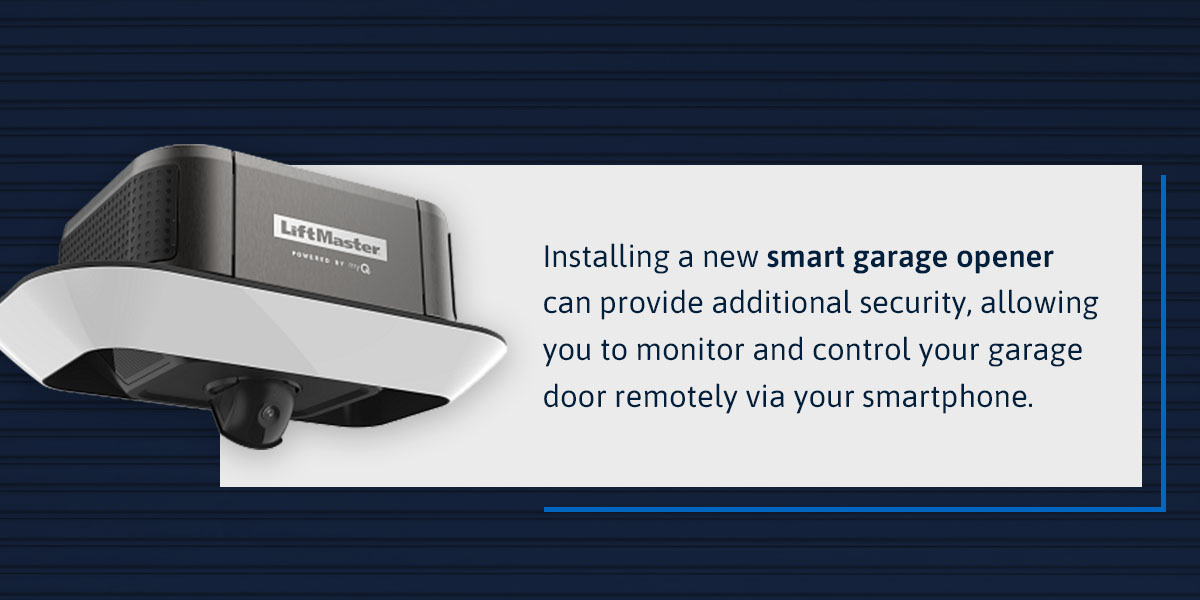
Check the door’s balance by disconnecting the opener and manually lifting it halfway. The door must stay in place. If it doesn’t, the springs may need adjustment, but this is not a fix you should attempt yourself. Consult a professional to ensure safe and proper adjustment.
Lubricate all moving parts, including hinges, rollers and springs, with a silicone-based lubricant. Lubrication ensures smooth operation, which is vital during the winter. It also helps prevent rust and corrosion.
Weatherproofing Your Garage Door
Weatherproofing your garage is essential for maintaining interior temperature and preventing drafts. Inspect the weather stripping around the garage door. Over time, this can become brittle, crack or fall off. Replace damaged sections to ensure a tight seal when the door is closed.
Examine the bottom garage door seal. When the door is closed, it should make full contact with the ground. If you can see light or feel a draft at the bottom of the door, it’s time for a replacement.
Check for gaps or cracks around the door frame. Pay special attention to areas where the frame meets the walls, as these are common spots for drafts. If you find gaps, seal with weatherproof caulk to prevent cold air from seeping in.
Insulating Your Garage
Proper insulation is fundamental to energy efficiency and comfort in your garage. If your garage walls are not insulated, consider adding fiberglass batts or foam board insulation to reduce heat loss and make the space comfortable for year-round use.
Remember to insulate the garage door, especially if your door is older. Install a garage door insulation kit to maintain temperature and reduce energy costs. These kits are relatively inexpensive and can often be installed as a DIY project.
Remember to insulate the ceiling, especially if you have a living space above the garage. Proper ceiling insulation keeps the garage warmer and prevents heat loss from the rooms above.
Heating Options
If you use your garage as a workspace or for storing temperature-sensitive items, you may want to consider heating options.
- Portable space heaters: These can be a good solution for occasional use, providing targeted heat when and where you need it.
- Ceiling-mounted heaters: For more frequent use, ceiling-mounted heaters can be a more permanent and efficient solution. These keep the heat source out of the way, freeing up valuable floor space.
- Radiant heating systems: Either installed in the floor or as panels on the walls or ceiling, these can provide even, comfortable heat throughout the space. While more expensive to install, they can be energy-efficient in the long run.
Whichever option you choose, ensure all heating devices are rated for garage use and follow all safety guidelines. Keep flammable materials away from heat sources and never leave heaters unattended.
Fall Storage Tips for Efficient Space Management
Effective fall storage tips can help you maximize space and keep your garage organized throughout the colder months. Follow these tips for proper storage:
- Garage cleaning for fall: Declutter your garage, identifying what you want to keep, donate or discard. After decluttering, clean your garage from top to bottom. Dust light fixtures, wipe surfaces and sweep, mop or vacuum the floor. Use a degreaser or stain remover for tougher grime, especially on workbenches or tool storage areas.
- Storing smaller items: Consider using airtight containers to protect smaller items like garden tools or sports equipment against moisture and pests. Label these containers clearly so you can find what you need.
- Storing a lawnmower: Drain the fuel tank or add a fuel stabilizer to prevent the fuel from degrading over the winter. Clean the undercarriage thoroughly to remove grass clippings, which can hold moisture and cause rust. Cover the mower with a breathable cover to protect it from dust while allowing air circulation.
- Special storage systems: Implement vertical storage solutions like shelves and pegboards to maximize floor space, keep items off the floor and make items easier to locate. Consider a ceiling storage system for items you won’t need until spring or summer. Be mindful of weight limits and ensure that ceiling-mounted storage doesn’t interfere with your garage door operation.
- Storing hazardous materials: Store hazardous materials like paints, chemicals or fuel in locked cabinets out of reach of children or pets. Ensure your fire extinguisher is easily accessible and not buried behind seasonal decorations.
- Pest prevention: Seal cracks or holes to prevent pests from seeking warm shelter in your garage during the fall and winter. Consider using natural pest deterrents like peppermint oil or cedar blocks near the door and in dark corners.
Proper fall storage ensures your items remain safe through the colder months and are easily accessible when the temperature rises. It also helps prevent slips or items from falling on you when you rush in to avoid the cold during the winter.
Trust Quality Door Company for Your Fall Garage Prep Needs
Preparing your garage for fall is paramount, especially for homeowners in the Midwest. Quality Door Company has covered you for professional garage door maintenance and comprehensive repairs. Our experienced technicians provide emergency repair services to address issues you’ve identified during your fall prep. We also offer comprehensive preventive maintenance to keep your garage door system running smoothly year-round.
Contact us today to schedule your repair, maintenance or replacement installation service and ensure your garage is ready to withstand the harsh Midwest winter.
What Garage Doors Have the Longest Life Span, and How to Improve Yours
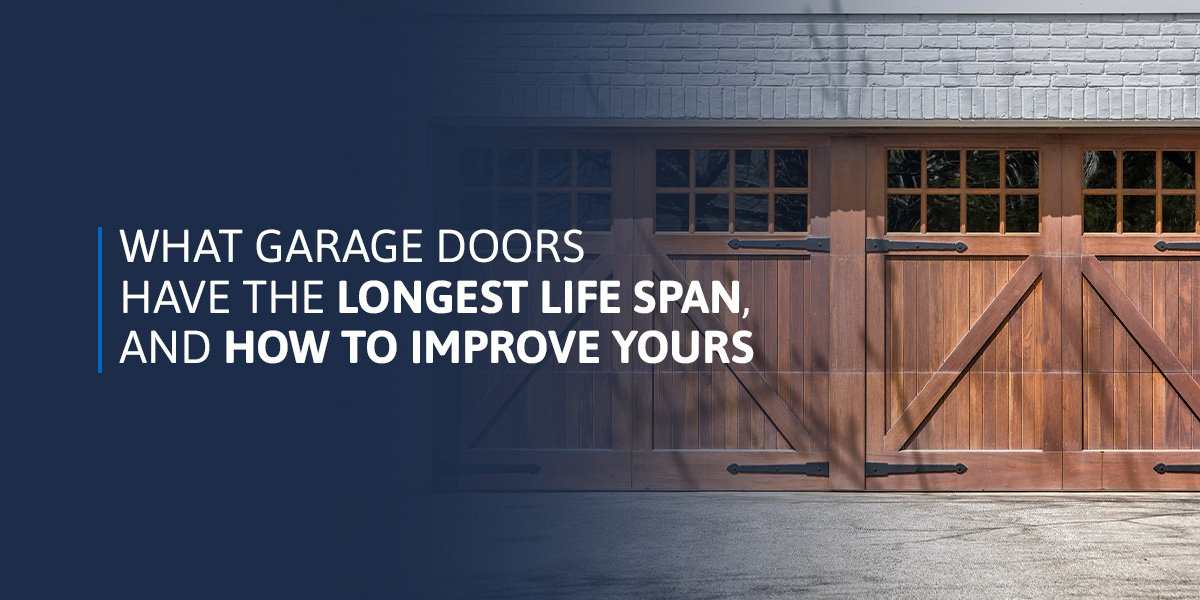
Garage doors benefit your home in many ways — providing security, access and curb appeal. That’s why you should keep yours in top condition. Knowing how long your overhead door and its core components last can help you better understand how to improve your garage door’s life span and when you may need to replace it.
What Is the Average Life Span of a Garage Door?
The average garage door life span is between 15 and 30 years. However, this estimate may vary based on various factors.
- Usage: While garage doors can last a long time, constant heavy usage can shorten their life span. Your overhead springs influence how many opening and closing cycles your door has. The more you use your door, the more wear you place on your springs, resulting in a shorter life.
- Care: Routine maintenance is one of the best ways to prolong your door’s life.
- Quality and price: Investing in a higher-quality door will enable you to enjoy a longer life span and get more from your investment.
- Local climate: Inclement weather like snow, wind and rain can sometimes damage your door and wear it out faster.
What Materials Provide the Longest Garage Life Span?
Some of the most durable overhead door materials include the following.
- Steel: Steel is one of the most reliable garage door materials. It is durable, low-maintenance and keeps your garage cooler. A steel overhead door can also maintain its shape over time, making it resistant to wear and tear.
- Wood: Many homeowners choose wood because of its aesthetic appeal and durability. Wood resists dents due to its natural strength.
- Fiberglass: Besides being resistant to warping or chipping, fiberglass can mimic textures like wood, making it an attractive and durable option. Fiberglass also resists corrosion, allowin you to take full advantage of its durability.
- Aluminum: Aluminum is fade- and rust-resistant, making it an ideal garage door option. Like fiberglass, aluminum is corrosion-resistant, allowing a longer life span.
- Wood composite: A wood composite overhead door has recycled wood fibers, giving it the look and texture of polished wood. Since this material is not 100% wood, it resists moisture and warping.
How to Increase the Longevity of a Garage Door
Preventive maintenance is one of the easiest ways to extend your garage door’s life span. Start by following these eight garage maintenance tips.
1. Be Mindful of How Much You Use an Older Door
The easiest way to prevent an older door from aging too fast is to use it less often. Your door and its components can only handle so many opening and closing cycles, and more frequent use exposes your door to extra wear and tear. While you don’t have to stop opening and closing your door entirely, try to use your garage door only when necessary and keep your remote away from children.
2. Check Safety Features
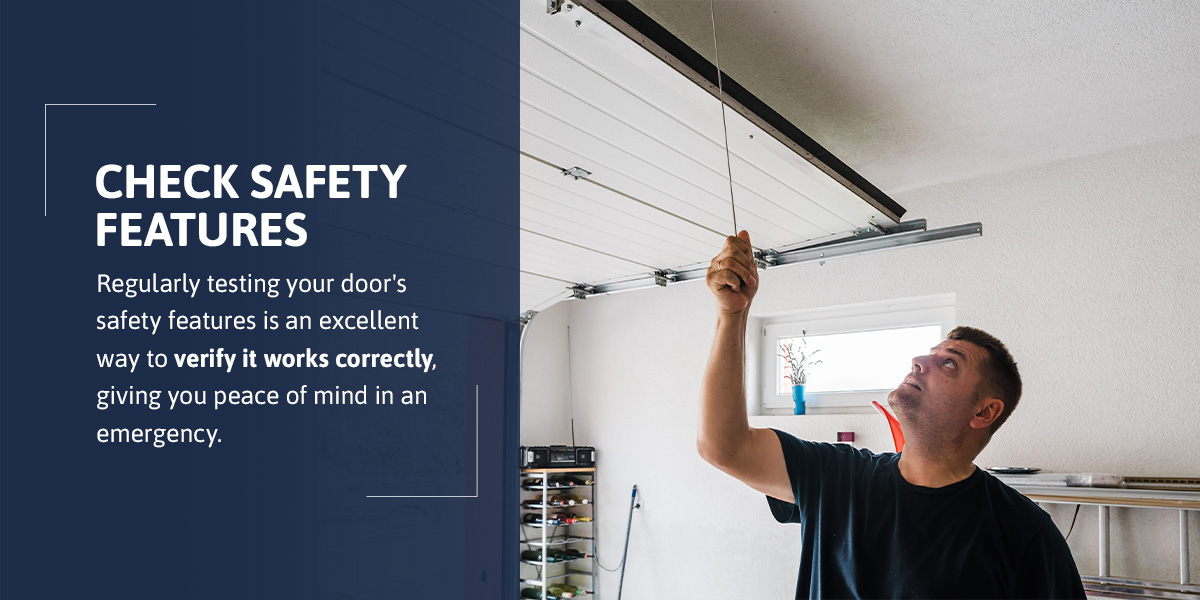
Regularly testing your door’s safety features is an excellent way to verify it works correctly, giving you peace of mind in an emergency. Double-check the sensors by putting a small object in their path during an opening or closing cycle. Pull the emergency cord to confirm you can manually move the door along its track.
3. Inspect All Your Garage Door’s Hardware
Your garage door has various screws, pulleys and springs, which can become loose or wear down over time. Checking the tightness of the hardware every few months and for wear every two years will allow you to quickly spot issues and ensure your door remains in excellent condition for longer.
4. Test the Door’s Balance
When you check your door’s emergency cord, you should also verify its balance. Pull the emergency cord and manually open the door halfway. A balanced door will remain in place, while an unbalanced door will fall. If you have an unbalanced door, call a technician to fix it.
5. Inspect the Door’s Weatherstripping
The rubber weatherstripping around the door’s outer edges prevents wind, water, bugs and debris from entering your garage. However, weatherstripping can wear down over time, so inspect and replace it as soon as you notice an issue.
6. Keep Your Garage Door Clean
A dirty garage door can cause corrosion or lose its pristine appearance. Washing your overhead door and the tracks can prevent rust and keep it looking beautiful.
7. Monitor the Cables
A garage door’s cables must be strong enough to lift the door without breaking. Frayed cables can fail, harming the door, yourself or your home.
8. Lubricate All Parts of Your Door
While every overhead door experiences natural wear and tear, lubrication can prevent damage from occurring too quickly.
When to Replace a Garage Door
Sometimes, it can be hard to tell whether your garage door has a few more years left or needs a complete replacement. Some signs you need to replace your door include:
- You want better insulation.
- Your door is noisy as it opens or closes.
- Your door opens or closes slowly.
- The door sags.
- You notice corrosion.
- The door has numerous dents and dings.
- If you have a wooden door, it is warping, cracking or peeling.
- The door no longer opens or closes correctly.
Find Long-Lasting, Durable Garage Door Options at Quality Door Company
If you need repair, maintenance or installation services, the team at Quality Door Company is proud to go above and beyond to keep your garage door in excellent condition. We have years of experience providing exceptional repair and maintenance services, and we can easily help you extend your overhead door’s life span.
When it’s finally time to replace your garage door, we’re a Clopay® Master Authorized Dealer® and offer durable, long-lasting overhead doors and openers to maximize your investment. Explore our wide selection of doors to find the right option for your home today!
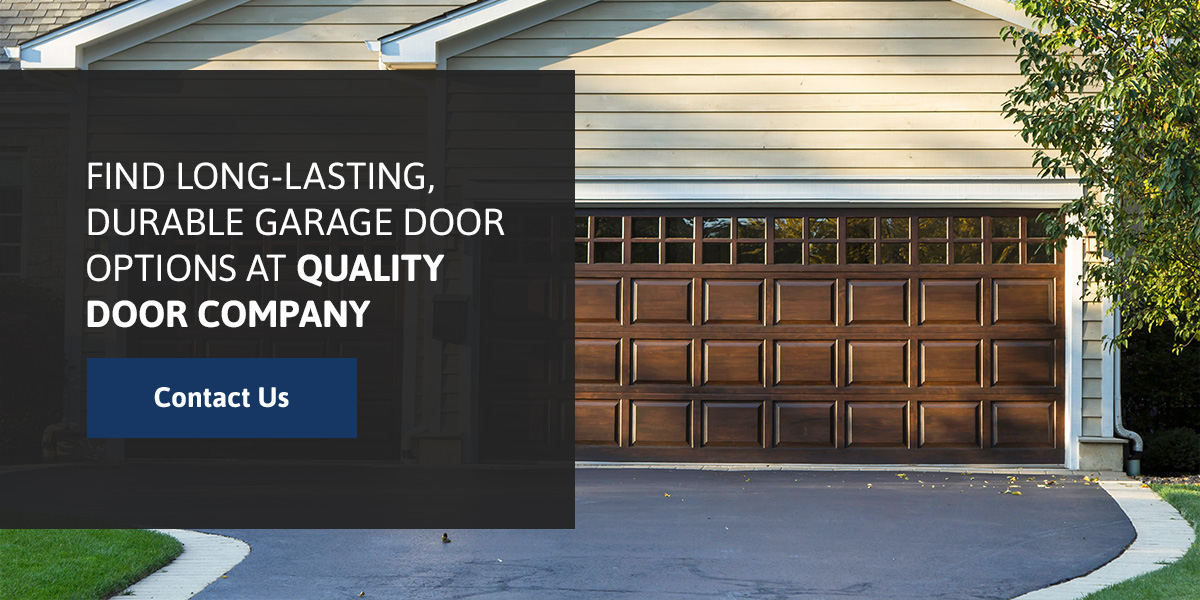
5 Reasons You Should Seal Your Garage Door
Garages and garage doors are integral parts of residential properties. Garages are convenient places to secure your vehicles, protect your valuables or use as extra space for your gym equipment, office or storage facility. For this reason, taking good care of your garage door is vital. Sealing your garage door is one of the most critical steps.
This article addresses the most common concerns about sealing your garage door. We’ll discuss five benefits of sealing your garage door, look at types of weatherstripping and explore the signs you need to repair or replace your garage door seal.
Benefits of Sealing Your Garage Door
Garage doors are one of the largest doors in your home. They protect your vehicle and everything else on the inside, so it’s crucial to ensure that the entire space is covered to protect your home. Sealing your garage door keeps insects, dirt and dust out, saves you more energy, keeps your home safe against burglars and provides insulation. Let’s consider these benefits in more detail:
1. Provides Insulation
Sealing your garage door with weatherstrips helps you regulate your home’s temperature. If there are gaps around the door, it’s easy for air, water and ice to enter your property. Sealing your garage gives you more control and allows you to use the space for several purposes. Moreover, it protects your vehicle and other metallic items against weather elements such as oxygen and moisture that induce corrosion. Insulate your garage door to shrink your bills and protect your property.
2. Saves You More Energy
Energy saving is one of the many benefits garage door seals offer. Energy saving personally benefits you and the planet at large. Sealing garage doors help you control your home’s temperature so your garage is cooler during the hot seasons and warmer during the cold seasons. This benefit translates into low energy usage, meaning you can save money on electricity bills and reduce your carbon footprint. Insulating your home can help you save around 10% on your annual utility bills.
3. Keeps Insects Out of Your Garage
Sealing your garage door reduces the access route for insects and pests. Insects and pests have the skills to maneuver their way into our homes, usually uninvited, and can crawl through any gaps in your insulation to establish colonies in your home. There may even be instances where the areas around the garage door are wide enough to accommodate bigger animals, like mice and rats, which can both cause damage and spread disease. Good garage seals close up extra spaces around your garage door to keep insects and pests out.
4. Keeps Dirt and Dust Out of Your Garage
As the wind blows, it carries dust into our homes through unsealed spaces. This dirt can make its way into your garage if it’s not sealed, gathering on your vehicles and other tools or appliances you store in your garage. Sealing your garage door keeps your garage dust-free and clean. It saves you time and effort on cleaning and makes your garage a comfortable place to work or spend time.
5. Keeps Your Home Safe Against Burglars
Seal your garage door to protect your home and family from burglars. Garage doors are secured barriers meant to keep our homes and properties safe. Burglars take advantage of gaps around the garage door and open it with crowbars. If the gaps in your garage door are already wide, they might spy through the gaps to see if you store valuables in your garage.
Best Ways to Weatherseal Your Garage Door
There are several ways to seal your garage door. You can use bottom seals or door sweeps, threshold seals, door-stop weather stripping and panel weatherstripping to keep your garage secure.
- Bottom Seal: This garage door seal effectively keeps debris, pests, insects and air out of your garage. They’re fixed at the bottom of the garage door, providing a tight barrier for unwanted materials. There are different types of bottom seals, including the bulb, J-type, T-type and beaded seals.
- Threshold seal: Threshold seal weatherstripping is conducive to water protection and it’s fantastic for filling large gaps. They are usually made of vinyl, rubber or aluminum and are fixed on the garage floor rather than the door.
- Doorstop weatherstripping: These vinyl or rubber strips are used on the sides and top of the door. The garage door presses tightly against the strip, preventing rain and wind from entering. Doorstop weatherstripping is easy to install and can be done using nails or screws.
- Panel weatherstripping: Panel weatherstripping is used for garage doors with panels. They’re made of flexible rubber and designed in a V-shape, which creates a tight seal. They insulate your garage against air loss and debris.
How Often Should You Replace Your Garage Door Seal?
Your garage door seal could last months or years — an average long life span is between five to ten years. The life span of the seal varies depending on several factors, including the material used and the level of maintenance. As a rule of thumb, check the seal once or twice yearly.
How Do You Know When to Replace Your Garage Door Seal?
Pay attention to the following signs to know if you should replace your garage door seal:
- Light passes through the weak portions of the seal.
- Air enters the garage through the spaces on the sides.
- The seal begins to crack or break.
- Puddles of water gather around the garage door or inside your garage.
How Do You Maintain Your Garage Door Seal?
The best way to maintain your garage door seal is to ensure preventive maintenance. This requires you to maintain the strips regularly according to the planned schedule to prevent unexpected failures. To increase the life span of the seal:
- Clean it regularly with warm water, detergent and a soft bristle brush.
- Inspect the seals regularly to ensure there are no gaps or breaks.
- Apply spray foam for extra protection against pests.
Remember, replacing weatherstripping on your garage door is one the best ways to protect your garage — take advantage of it!
Contact Quality Door Company to Learn More about Sealing Garage Doors!
The benefits of weatherstripping garage doors are many. They offer extra protection, make your garage more energy efficient, provide additional insulation and protect your home against dust, water, snow, insects and burglars. It’s important to choose the kind of seal that is right for the part of the garage door you want to seal and check it once or twice a year to ensure it’s in good condition.
Quality Door Company is the leading dealer in residential garage doors in Western Michigan. We offer personalized maintenance services and carry high-quality models such as Clopay, Liftmaster and Cornell. Do you want to learn more about weatherstripping and insulating your garage door? Contact us today!
Troubleshooting Garage Door Issues
Anyone with a garage has experienced garage door issues. Whether your door is moving too fast or too slow, making unusual noises or just not doing what you want, garage door problems can quickly turn a productive day into a frustrating one.
Most people want quick fixes that show effective results. We’ll take you through how you can handle some common garage door problems at home as well as how to know when you should call for professional assistance.
Alignment Issues
Most common garage door problems tend to come down to alignment, which plays a crucial role in keeping your system running smoothly.
Sometimes you’ll be able to see or hear that something is wrong. If it looks like one side of the door is moving at a different pace than another, or you hear clanging and screeching, you might have an alignment issue.
There are several reasons your door could be out of alignment, including:
- Broken cables
- Faulty springs
- Dusty or bent tracks
- Harsh weather
While broken garage door cables and faulty springs signify a more significant problem, there are measures you can take to check your tracks and inspect for weather damage.
Harsh winter conditions like wind and snow can forcefully move your door out of alignment. Rain can cause rust build-up on hinges or springs. Be sure to check for weather damage after severe weather and request panel repairs if you notice any.
If your garage door tracks are out of alignment, you can realign them by loosening the screws to unlock them and gently tapping them with a mallet or similar tool. If you need to adjust the lower tracks, you’ll need to remove the brackets. Always ensure the tracks are completely level to allow smooth operation.
After realigning your tracks, retighten all nuts, bolts and brackets to secure them in place.
Pace Issues
A garage door that opens too slowly or shuts too quickly is usually a sign of issues with your tracks, springs or cables. While you can handle some of these issues yourself, some will require professional repairs.
Too Slow
If your slow-moving garage door is a cause for frustration, try these quick tips for garage door issues to improve its speed.
Start with wiping everything down. Dirt, leaves, debris and other natural elements can quickly pile up on your tracks and other moving parts. Take a rag and wipe everything off to help clear the way for a faster-running door.
Next, you’ll want to lubricate everything properly. Your door has lots of moving parts and pieces and keeping them free of rust and build-up helps them keep working smoothly and efficiently. Adequately lubricating your components will also help save wear and tear, increasing the life of each part.
If your door is still moving slowly after you’ve cleaned and lubricated your system, you should call a professional to take a look. A technician will evaluate the condition of the springs and pulleys to ensure there isn’t a more significant issue.
Too Fast
Quick-moving doors typically indicate a problem with your springs or cables. These issues can present a severe danger, as the door may not stop when a person, pet, vehicle or other object is in its path.
Keeping these parts well-lubricated can help prolong their life. When you notice your garage door closing too quickly, call a professional to check and replace your springs and cables before they break. You should avoid using your door and leave your car parked outside the garage until you replace them.
It’s critical to leave these repairs to a professional rather than attempting them yourself. Loose springs (especially older style extension springs) can fly out and pierce people or objects, and snapped cables can lash out at anything in proximity.
You should contact a professional about door cable repairs immediately if you hear loud banging and aren’t sure of the cause. If you notice screeching or creaking sounds, it’s likely time to call for spring repair.
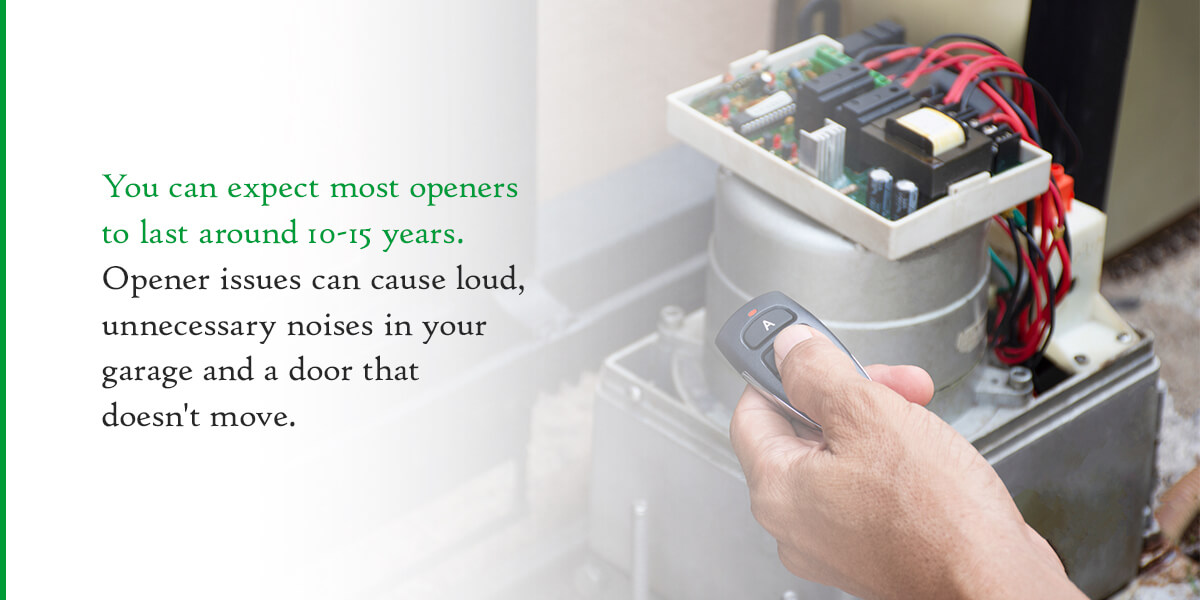
Drive Gear Issues
You can expect most openers to last around 10-15 years. Opener issues can cause loud, unnecessary noises in your garage and a door that doesn’t move.
The main drive gear is the cause of most opener issues. While removing and replacing this part by yourself can be challenging, it is possible. You’ll need to access and remove the shaft and use a punch to remove the gear to replace it with a new one. If you opt to insert a new shaft as well, you can find kits that have all you need. Once you’ve replaced all the parts, you’ll want to lubricate everything thoroughly to ensure seamless operation.
However, if your opener motor has reached the end of its usable lifespan, you’ll need to replace it entirely. Contact professionals to repair or install your door opener rather than trying to do so yourself.
Sensor Issues
Many issues with garage door openers stem from parts not receiving the signals they need. To ensure the door opens and closes properly, you’ll want to check the connection and status of the:
- Photo-eye sensor
- Remote
- Antenna
Ensure that your antenna is free of any plant life or debris, and check your remote batteries. To help determine if your remote is causing the issue, try using it inside your garage. If your remote doesn’t work when the wall button does, the remote likely needs fresh batteries.
Photo-Eye Sensor
You can find the photo-eye sensors on either side of the garage door opening. The two sensors have an invisible connection that alerts them if something is in the door’s path. This connection prevents the door from closing on vehicles, toys, pets or people. If the sensors lose their connection, the door will not close.
The first thing you’ll want to do is clear the path. Branches, twigs and shrubbery can cause a broken connection between your door sensors. Also check for any tools, toys or other household items.
Lights and Wires
If you clear the path and the door still won’t close, wipe the sensors with a soft cloth to ensure dirt and dust aren’t blocking the signal. If you’re still experiencing issues, look closely at each sensor. You should notice two lights:
- The green light sends signals and notifies you of problems.
- The red light receives signals.
Either light blinking indicates a photo-eye issue.
A blinking red light paired with a solid green light likely means the sensors are out of alignment. You can carefully adjust the sensors to ensure they properly send and receive signals. It’s best to do this while blocking the sun to keep the rays from interfering with the light signals.
If both lights are off, there’s an issue with the power supply. You’ll want to check that the cable is still plugged in and that you didn’t blow a fuse.
In some cases, you may have tangled or broken wires. You can safely separate tangled wires. However, if you notice any damaged or punctured wires, you should call a technician to resolve the situation.
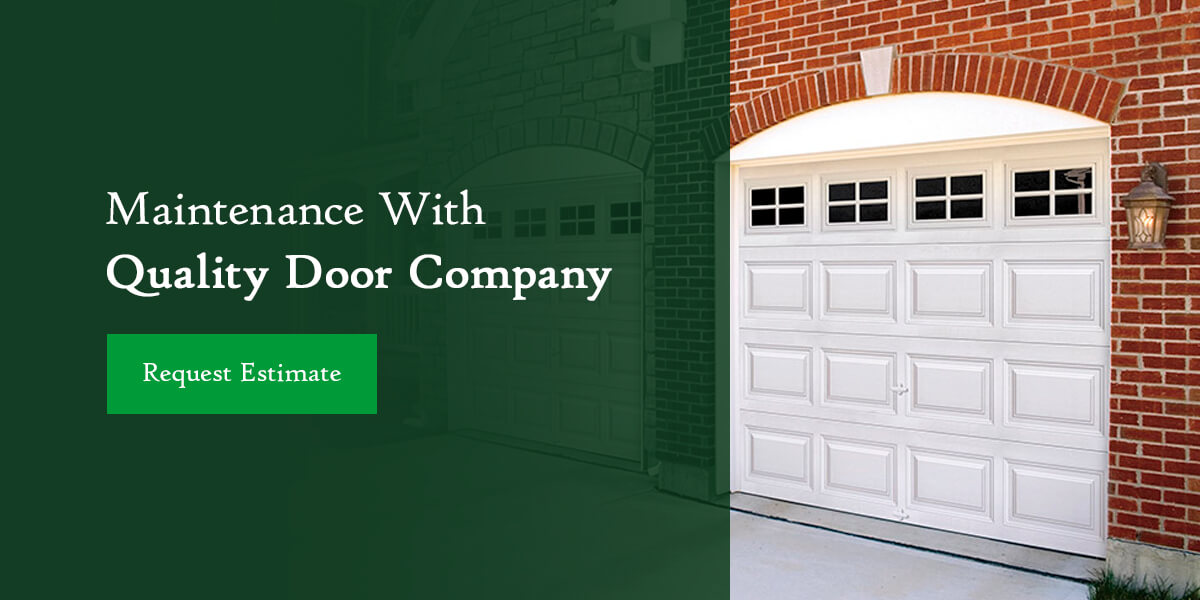
Maintenance With Quality Door Company
At Quality Door Company, we give what our name suggests, providing high-quality service to install and repair high-quality doors. We provide excellent service to anyone who needs garage repairs in the Western Michigan areas.
We know you want to rely on someone dependable. With over three decades of experience, we’re happy to take on that role. Request preventive maintenance with Quality Door Company to keep your garage up and running for years to come.
5 Tips for Preparing Your Garage Door for Winter
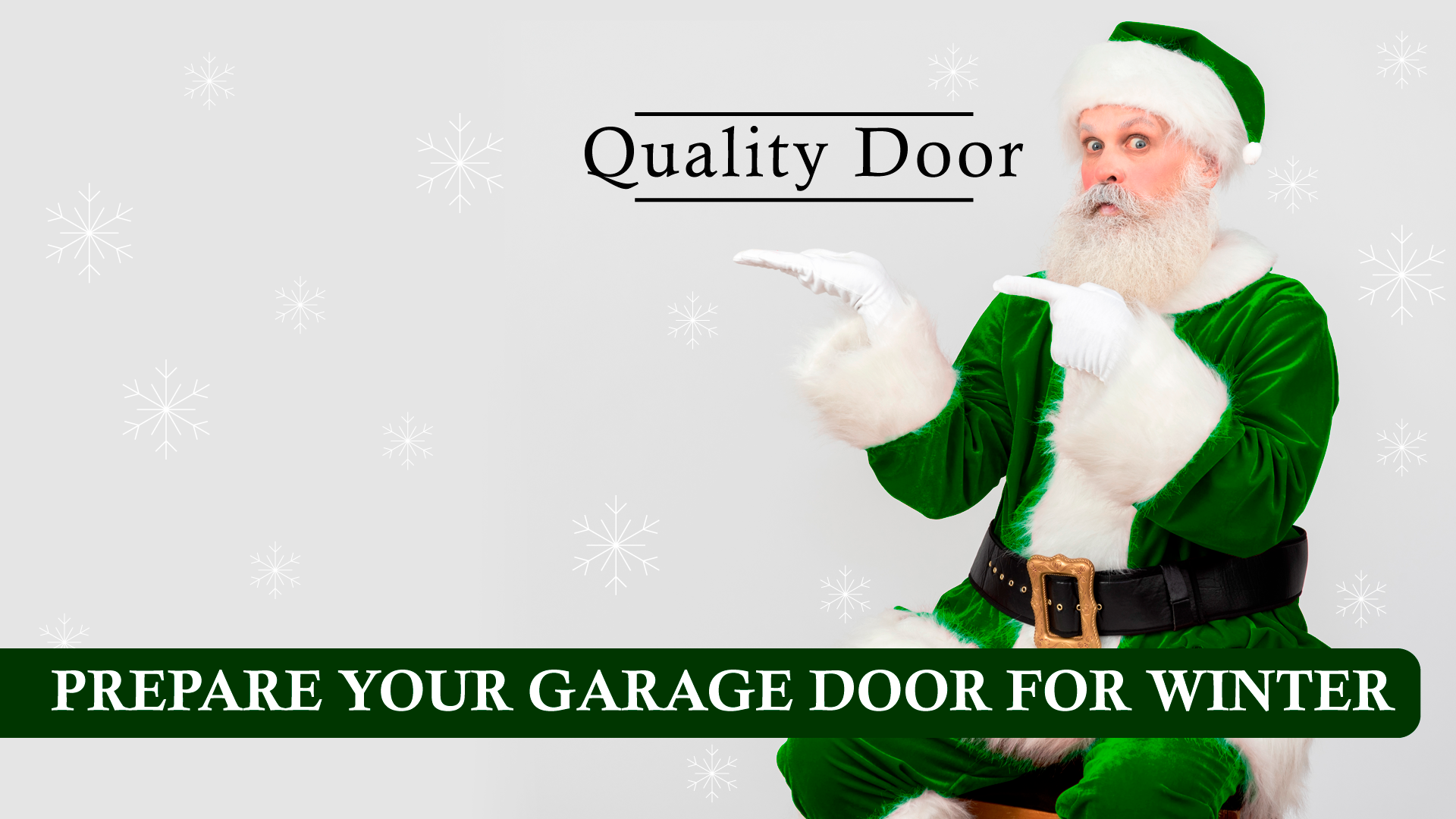
Winter is right around the corner, which means that the effects of cold weather will begin soon. Michigan homeowners know that there are many tasks to complete before the snow and ice arrive, whether it’s finishing up summer projects or cleaning out the gutters to avoid issues during the freezing months.
Your garage door is an essential part of your home, especially if you want to keep your car out of the snow. Protecting your garage door from cold temperatures can help you increase its lifespan and prevent surprises during the winter. Ensuring your garage door is properly winterized for the cold weather can help protect the moving parts within your garage door system, reducing the risk of needing an emergency repair. Below, we’ll go into some garage door maintenance tips to keep your garage door in working order when the cold weather strikes.
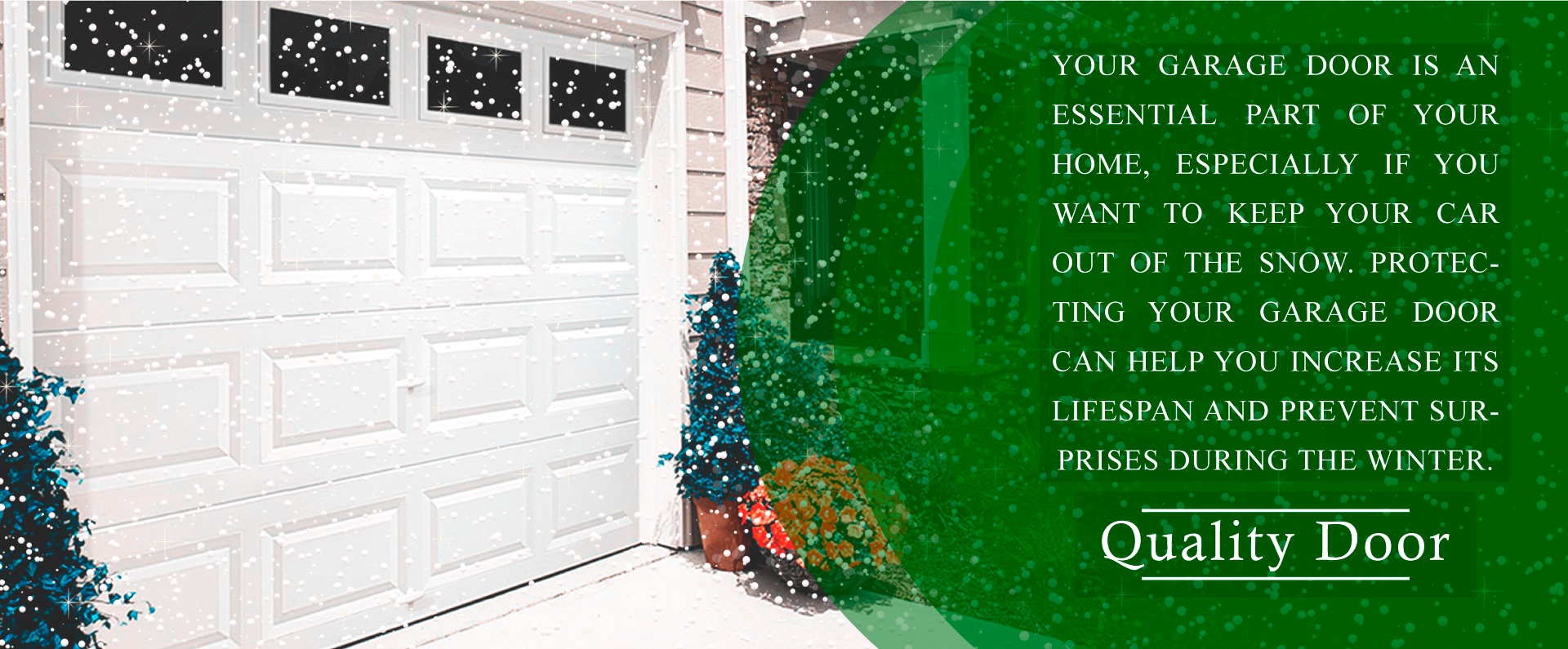
Why You Should Prepare Your Garage Door for Winter
While there are probably lots of things on your to-do list as you prepare for winter, you shouldn’t cross off your garage door preemptively. Taking the proper steps to prepare your garage door for winter can significantly affect your home as the weather gets colder. Here are four ways that winterizing your garage door will help you long term.
1. Increase the Life Span of Your Garage Door
As with most things in your home, your garage door greatly benefits from regular maintenance. Taking care of your garage door helps sustain the door for longer. Your garage door is a home appliance that you likely use every single day, which means that it undergoes lots of wear. Taking good care of your garage door not only ensures convenience for the time to come but also helps you avoid an expensive bill that comes with replacing a garage door.
2. Improve your Home’s Energy Efficiency
One of the goals of winterizing your garage door is ensuring that the insulation is thick enough to prevent large amounts of cold air from getting into your garage. Interior walls shared with the garage are prone to letting in freezing air from the garage through the walls and the interior garage door. You can spend less money to heat your home by keeping your garage warm and avoiding the cold air seepage into your home’s interior.
3. Protect Your Pipes in the Garage
Some homes have water pipes that run through the garage. Extremely cold air can cause these pipes to become brittle and burst, which creates serious plumbing damage. Burst pipes also mean potential water damage to things inside your garage. You can save stress by keeping your garage warm to prevent burst water pipes that could have easily been avoided. By winterizing your garage door, you extend the life of the door itself and the contents in the garage, including the water pipes.
4. Store Items Safely in Your Garage
While burst water pipes can cause severe damage that you want to avoid, you also need to protect the items in your garage from another risk in the winter: moisture buildup and damage. The cold winter air is filled with water from the snow. Boxes of stored possessions, power tools and even shoes may be irreparably destroyed by the moisture in the air. Items near or on the floor are at the highest risk of moisture buildup.
How to Winterize Your Garage Door
As long as you regularly maintain your garage door, winterizing it is easy. An important factor to consider is when to prepare your garage for the season change – you likely will not want to begin this process after the temperature has dropped and snow has started to fall. Follow our five tips for how to winterize your garage door before winter actually arrives to ensure a pleasant and easy experience.
1. Inspect the Garage Door and Its Tracks
Although it seems simple, inspect your garage door and the tracks. Watch and listen as the garage door goes up and down a few times, and note any sounds it makes. Pay attention to whether the door gets caught in any particular spots. The severity of what you find during an inspection will tell you whether you need to call a professional for help. Regular tune-ups are important for increasing your door’s life span, and it’s better to address issues before the snow arrives rather than be surprised.
2. Inspect Your Garage Door Opener and Its Safety Sensors
Spend some time inspecting your opener for any broken parts. As with the door and tracks, a quick inspection of your opener should tell you whether you need to call for maintenance. Check that your safety sensors are working properly, as well. If your garage door keeps pausing as it opens or closes, there could be an issue with the sensors. Snow can quickly pile up and inhibit the effectiveness of the sensors, so be sure to get out ahead of this to ensure your door works throughout the winter.
3. Check the Weather Stripping Around Your Garage Door
The weather stripping, also referred to as your rubber seal, around the perimeter of the garage door keeps out cold air, dirt, debris and bugs. Heat exposure and extremely cold weather decay the stripping, and any small damage can render it completely useless. Cheap, flimsy stripping also has minimal effect on keeping cold air and weather elements out of the garage. If you find cracks, tears or missing pieces, the entire strip should be removed and replaced. Changing only small pieces can leave small openings between the strips, which counteracts the work you put in.
4. Lubricate the Moving Parts of Your Garage Door
Many of the moving parts to your garage door are metal, which means that lubrication is essential for keeping them running smoothly. Springs, rollers and hinges are all parts of the door that need regular maintenance. A non-silicone lubricant is ideal, and avoid using sticky grease that collects debris. Fresh lubricant is less likely to dry or freeze during the cold weather. Avoid common household spray lubricants such as WD-40 when lubricating your garage door. WD-40 will end up softening plastic, nylon, or rubber components.
5. Add Insulation to Your Garage Door
Your garage door and walls will require proper insulation to keep your garage warm during the winter. Insulation on a garage door prevents moisture buildup that can freeze. This buildup makes the door heavy and may prevent the door from opening at all. Many newer garage doors come with built-in insulation to ensure temperature regulation. Exterior walls should also have plenty of insulation in them, as cold air can easily seep through gaps. Make sure that the walls are undamaged before adding insulation for the winter.
Who Can Help With Winterizing Your Garage Door
Start Preparing Your Garage Door for Winter Today
Garage Door Maintenance Guide
Preventive maintenance prolongs the life of your garage door. Even if your garage door works fine without it, simple routine maintenance at least twice a year can extend the life of your garage door.
You may need frequent maintenance if your garage door or opener is older and suffers from heavy use. Call a professional garage door company right away if you have any safety concerns and refrain from using the door. Be on the lookout for signs that indicate your garage door may have a problem. This guide to garage door maintenance will help you prevent surprise repairs in the future.
Benefits of Regular Maintenance on Your Garage Door
Regularly maintaining your garage door ensures that your cables, springs, openers and rollers are in working condition. They must function together to lift your garage door up and down. Keeping these parts in good condition increases the life span of your garage door.
Maintaining the components of your garage door and making minor repairs is much more affordable than replacing your existing door. It can help catch problems and avoid costly repairs.
Regular maintenance increases your home security, preventing any unauthorized access from intruders or thieves. If your garage door breaks down, they may have easier access to your possessions and home.
A faulty garage door system can potentially destroy your home and vehicle. Most of the time, garage doors stop working or break while they’re in motion. Your vehicle could be directly under a failing garage door.
A garage door malfunction can negatively impact your home because of its heavy components. This can damage the structural integrity of the garage constructed surrounding it. Following this garage door servicing guide will help keep your system running safely.
How Often Do Garage Doors Need Maintenance?
Performing preventive maintenance twice per year helps extend the life of your garage door. The change of the seasons can help you remember when to service your garage door. Checking your garage door in the fall ensures that it can seal out snow and freezing temperatures. When springtime comes, you can check your garage door again for any damage caused over the winter.
There are common signs to look out for that indicate there may be an issue with your garage door. These may require a repair or sometimes a full replacement:
- The garage door isn’t opening or closing — or is only opening and closing halfway.
- The garage door is very noisy when operating.
- The garage door doesn’t operate even when the motor runs.
- The garage door has broken glass — if it has any glass windows.
- The garage door won’t open manually from the outside without an opener.
It’s good to perform your own monthly check to make sure that none of these issues have occurred. Reporting any recent changes can help your service technician figure out how to fix your garage door faster.
Garage Door Maintenance Checklist
Most people use their garage doors several times a day, which adds up to thousands of times per year. You rely on your garage door and need it to work properly every time.
It takes only a few hours of maintenance to ensure that your garage door runs efficiently throughout the year. You can follow this simple checklist to inspect your garage door:
- Check rollers and hinges: It takes an intricate system of rollers and hinges to lift your heavy garage door. Check to make sure that each piece is secure and functioning properly. Over time these parts can wear and crack. If you notice any damage, you can contact a professional to replace these parts.
- Tighten up the hardware: A garage door relies on dozens of small parts to open and close properly. A large amount of movement and vibration can cause its hardware to loosen. If you have a socket wrench, you can tighten all the bolts and screws yourself.
- Lubricate: Garage doors have a lot of moving pieces that rub together multiple times per day. Too much friction can cause unpleasant noises while the garage door is in motion. It’s important to reapply lubricant to keep these parts functioning smoothly. You can use white lithium grease on the opener’s screw or chain and a spray lubricant such as WD-40 to coat the overhead springs.
- Replace weatherstripping: At the bottom of your garage door, there is a long piece of weatherstripping that seals out pests and keeps your garage door insulated. Over time, it can wear out or become loose. Make sure that there are no gaps where your garage door meets the ground. If you notice your weatherstripping is brittle or cracked you should have it replaced immediately.
- Check the cables: Check the condition of your garage door cables so you know when to hire a professional. You should never mess with the high-tension cables that lift your garage door because they have enough force to cause serious injuries. Check for damage and broken strands near the bottom of the roller bracket.
- Test the safety sensor: Modern garage doors come standard with a photo-eye sensor that prevents your door from closing on your child, pet or belongings. It prevents accidents by reversing the door if someone or something wanders below. You can check the sensor by placing a scrap piece of wood or another inanimate object under the door while it closes. If it fails to reverse, you should contact a garage door specialist right away.
- Examine the alignment: Garage doors must be balanced to function properly. You can check the alignment of your garage door by disconnecting the opener and trying to lift it by hand. It should open easily with light force. When you open it halfway, it should stay in place on its own. If your garage door is hard to open or falls back to the ground, you should call a service technician for an alignment.
Who Should Service Your Garage Door?
With the help of a regular garage door maintenance guide, homeowners can service their own door and make minor repairs. Although, not everyone is comfortable with fixing the opener or replacing the tracks. A garage door repair professional can assist you with these tasks as they have the necessary knowledge and experience to handle all types of installation and repair services. Here are some of the benefits of hiring a professional garage door service provider:
- Expertise: Professionals understand the working of a garage door and can easily identify its issues. Timely repairs help increase the life of the garage door.
- Appropriate tools: Garage door repair projects sometimes require expensive tools that can only be appropriate for a specific job. A garage door repair professional has the right tools to cater to different projects.
- Avoided injuries: Garage door service providers use tools that are safe and can complete garage door repair and installation projects correctly. They work in teams to prevent accidents and know when to hold the door while it’s in service.
- Affordable: Professional garage door maintenance can save you money in the long run. Hiring a professional gives you peace of mind that the work is completed on time and of the best quality. That way, you can avoid a full replacement if there’s damage.
Receive Garage Door Maintenance From the Experts at Quality Door Company
It’s essential to maintain your garage door’s condition for your financial and physical well-being. Whether it’s residential or commercial, caring for your door with regular maintenance by expert professionals protects your investment and prevents major issues from occurring. Taking care of your door prevents injuries and property damage.
Our crew at Quality Door Company can catch common issues in residential and commercial settings. We provide affordable maintenance services to ensure that your garage door is reliable and efficient.
For more information on services or rates, contact Quality Door Company online today or schedule a service appointment.
Broken Garage Door Spring — What Are The Causes?
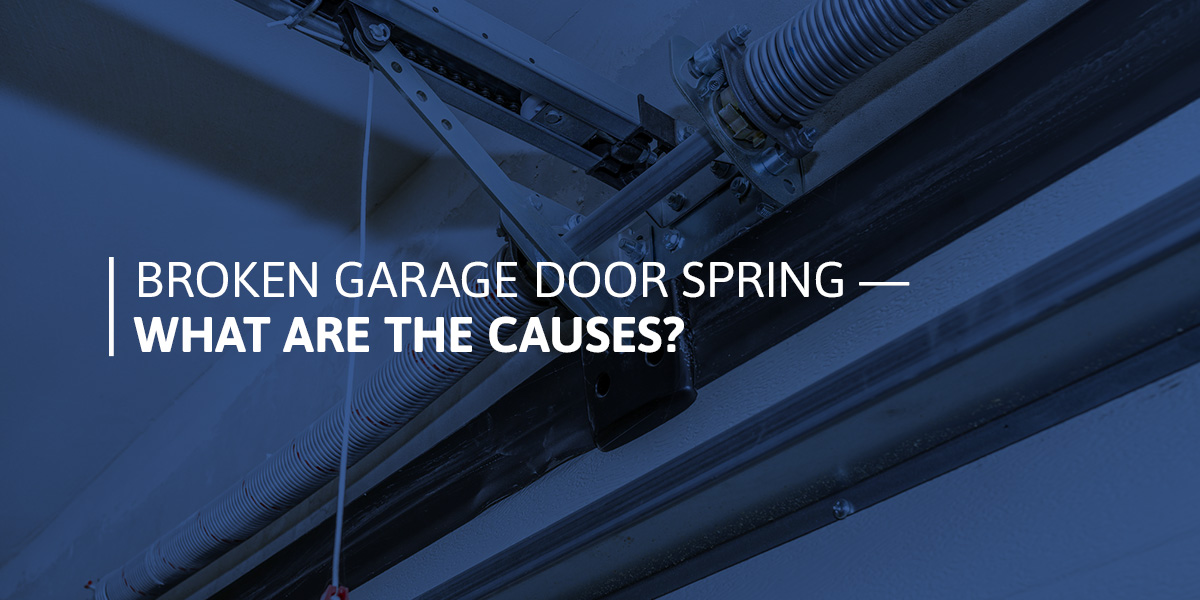
Garage door springs are tiny components with a crucial job. Opening and closing your garage door applies extreme force to the springs over time. Broken or snapped springs can no longer move the door, which is one of the leading causes of garage door malfunction. How long a spring will last before breaking depends on several factors. You should know who to turn to when they finally wear out and need replacing.
If you hear a spring break or think your garage door springs’ life span is near its end, contact the professionals at Quality Door Company. We offer standard and emergency services to handle all your garage door spring issues. Our team of expert technicians has the training to service and replace springs for all makes and models of garage doors.
DIFFERENT TYPES OF GARAGE DOOR SPRINGS
There are two types of garage door springs.
1. TORSION SPRINGS
Torsion springs turn as your garage door closes and store wound-up energy. If your garage door uses torsion springs, they use collected power to open the garage door through a torsion system. When torsion springs properly balance a garage door, it opens and closes easily. Torsion springs sit either above the garage door or in the back of the garage, and they typically resist wear and tear longer than extension springs.
2. EXTENSION SPRINGS
Extension springs run along horizontal tracks that attach to your garage door brackets with cables. In some cases, they sit above the garage door tracks. Generally, if your garage door springs are on either side of your garage door, you have extension springs.
They stretch fully as your garage door closes. When you open your garage door, the springs contract and pull the garage door up. Extension springs stay outstretched while the door is closed, experiencing significant pressure that leads to damage over time, limiting your spring system’s life cycle.
HOW LONG DO GARAGE DOOR SPRINGS LAST?
Garage door springs’ life span depends on many factors.
USAGE FREQUENCY
On average, extension garage door springs last 10,000 open-and-close cycles, about three to five years for most home and business owners. Your springs can last over 13 years if you usually open your garage door twice a day. On the other hand, the springs may wear out within approximately four and a half years if you open your garage door six times daily.
With more homeowners using their garage doors as the primary entrance to their home, many find their garage door springs wear out sooner because of the heavy use.
TYPE OF SPRING
The two garage door spring types have different life expectancies. Torsion springs generally last longer than extension springs because they are not under constant pressure. Quality torsion springs can sometimes last anywhere from 15,000 to 20,000 cycles. Extended life span torsion springs can last four times as long as conventional torsion springs. Having two torsion springs on either side instead of one can also put less pressure on the springs and extend their usable life span.
MAINTENANCE PROCEDURES
You can prolong your garage door spring life expectancy with regular preventive maintenance. By replacing springs when wear and tear first occurs, you can avoid snapped or broken springs that prevent your garage door from opening and closing. Preventive maintenance also reduces the risk of a more expensive emergency service call.
Quality Door Company offers the following maintenance procedures.
- Inspecting pressure levels: Professionals maintain your complete garage door system, including the springs, to ensure no component puts excessive pressure on the springs.
- Lubricating the system: Our expert technicians lubricate the springs to prevent friction and rust that can make them wear out sooner.
- Checking spring condition: A professional will check your entire spring assembly and its tension and recommend whether you should replace any parts.
When we visit your home for maintenance procedures, we do more than check the springs for wear. We look at your complete garage door system. We may find another part of the garage door is not working correctly or placing unnecessary pressure on your springs. In that case, our expert technicians can address the issue before it shortens your door’s life span.
WHY DOES A GARAGE DOOR SPRING BREAK?
Garage springs are vital for keeping your garage door operational. However, various factors can deteriorate your garage door springs. This list will cover typical reasons garage door springs break.
WEAR AND TEAR
Wear and tear are common culprits of broken garage door springs. Springs are subject to significant stress and tension during the door’s daily operation, leading to gradual degradation. The constant contraction and expansion cycles weaken the metal, ultimately causing it to snap. Regular use accelerates wear and tear, especially during extreme temperature fluctuations. Garage door maintenance is crucial for preventing problems and keeping your door in good shape year-round.
LACK OF MAINTENANCE
Neglect is another significant contributor to garage door spring failure. Lack of lubrication on the springs can result in increased friction and wear. Putting off routine inspections may lead to unnoticed issues, allowing minor problems to escalate into full-scale failures. Proactive maintenance can prevent many of the reasons garage door springs break. You can mitigate risks by remembering to perform frequent lubrication and visual inspections.
RUST AND CORROSION
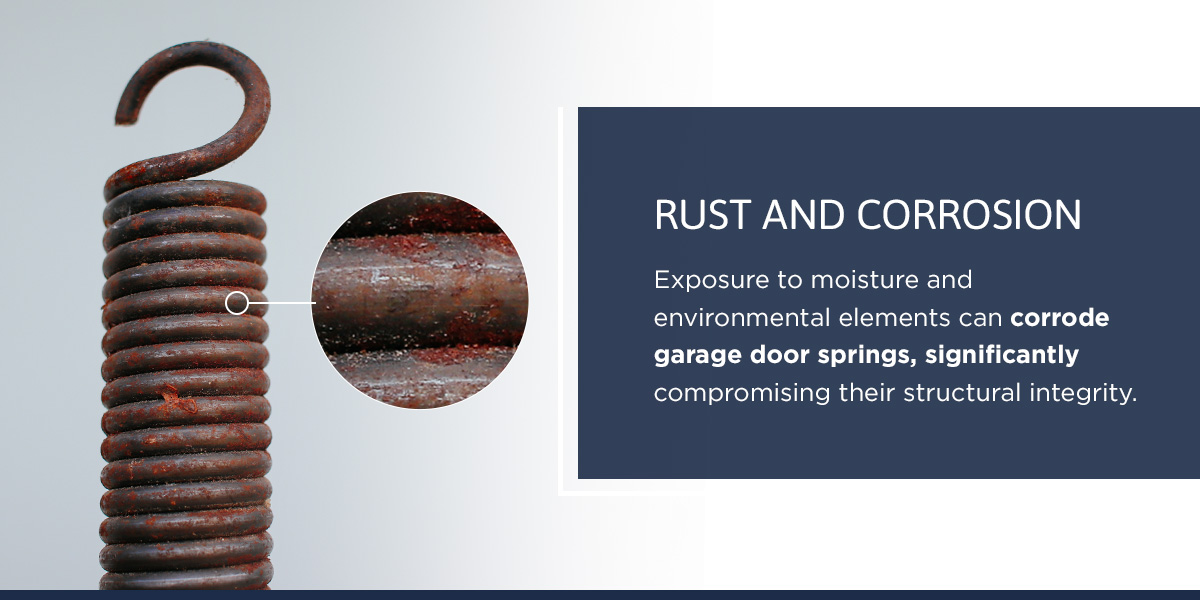
Exposure to moisture and environmental elements can corrode garage door springs, significantly compromising their structural integrity. Rust weakens the metal, making it more susceptible to fractures. Applying rust-resistant coatings and addressing rust spots promptly with cleaning and treatment can extend your springs’ life span.
POOR-QUALITY SPRINGS
The garage door springs’ quality is critical in determining their longevity. Substandard springs may not withstand the tension and stress, leading to premature failure. Invest in high-quality springs to ensure they can handle the stress of regular use. Superior springs are better at enduring environmental conditions, reducing the likelihood of unexpected breakage.
Spring size is another factor to consider here. They will wear out faster if they are too large or too small for your garage door.
DIY REPAIRS AND ADJUSTMENTS
While do-it-yourself projects can save money, they can also backfire on you without proper training and tools, inadvertently leading to severe issues. Garage door springs are under substantial tension, and attempting amateur repairs poses significant safety risks.
Adjusting the garage door spring tension is not a DIY task and can be dangerous if you do not understand the intricacies of the garage door system. Incorrect adjustments can result in uneven tension distribution that unnecessarily strains the springs. Additionally, trying to fix issues without the appropriate tools can further compromise your garage door’s quality.
WHAT TO DO WHEN YOU NEED TO REPLACE YOUR GARAGE DOOR SPRINGS
While it is usually impossible to repair broken or damaged garage door springs, you can call the professionals at Quality Door Company for a total replacement. Our knowledgeable technicians will safely remove the old, worn-out springs and replace them with the optimal type and size for your garage door.
You may notice a few signs when you need to replace your torsion springs.
- Unexpected noise: You might hear a loud bang or snapping noise when a spring breaks.
- Ineffective mobility: Your garage door may get very heavy or stop moving entirely.
- Visible damage: Breaks, gaps, stretched-out and uneven springs all indicate the need for a replacement.
When you notice or suspect any problems with your springs, contact the experts at Quality Door Company for prompt and courteous service that prevents accidents or further damage. Unfortunately, you can’t complete a garage door spring replacement with your everyday household toolbox. Spring replacement is a task best left to the professionals. Garage doors have complex systems that can be dangerous for untrained homeowners. The team at Quality Door Company will replace and repair your garage door springs while keeping you safe.
CONTACT QUALITY DOOR COMPANY FOR GARAGE SPRING ASSISTANCE
Since 1984, our family company has offered outstanding garage door installation, repair and maintenance services to homeowners and businesses in Western Michigan. We work with all makes and models and get your garage door working smoothly as soon as possible.
Quality Door Company can help if your garage door stops working or you notice anything unusual. Contact us today for a free quote.

